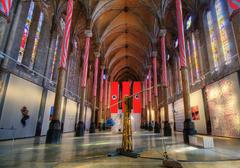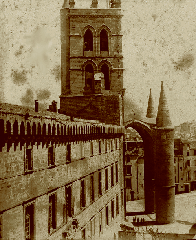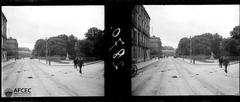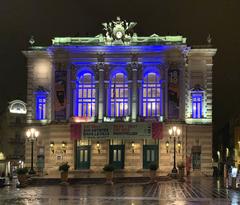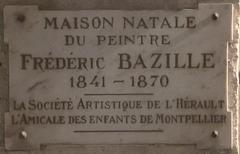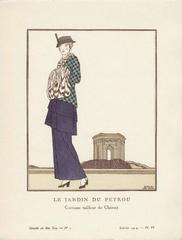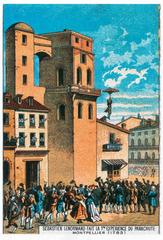
Temple of Maguelone Visiting Hours, Tickets, and Guide in Montpellier, France
Date: 04/07/2025
Introduction
Located in the vibrant heart of Montpellier, the Temple of Maguelone (Temple protestant de la rue Maguelone) stands as a prominent symbol of the city’s religious and cultural diversity. This 19th-century Protestant temple is not only an architectural gem with its neo-Byzantine design, but also an active place of worship and a dynamic cultural venue. Its strategic location on Rue de Maguelone, connecting key urban landmarks like Place de la Comédie and Gare Saint-Roch, positions it as both a historical monument and a living part of Montpellier’s urban and social fabric. This guide provides detailed information on the temple’s history, architecture, visiting hours, accessibility, tickets, and practical travel tips to help you plan an enriching visit (lescarnetsdemontpellier.fr, montpellier.epudf.org, Guide Tourisme France).
Historical Background
Origins and Development
The Temple of Maguelone was inaugurated in 1870 during a period of significant urban renewal in Montpellier, inspired by the modernization projects of the Second Empire. The construction of the temple on the newly established Rue de Maguelone was championed by Mayor David-Jules Pagezy, reflecting the aspirations and civic engagement of Montpellier’s Protestant community (lescarnetsdemontpellier.fr). The street itself is historically significant, serving as a thoroughfare linking the city center to key transportation and commercial areas, and its name recalls the medieval Maguelone Cathedral and the historical presence of the Knights Templar in the region (Montpellier History, Knights Templar in France).
Religious and Social Role
More than just a house of worship, the Temple of Maguelone was envisioned as the centerpiece of a Protestant complex that included schools, a pastor’s residence, and charitable institutions. This vision underlined the community’s commitment to education, social care, and mutual aid, securing the temple’s place as a hub for spiritual and civic life in Montpellier.
Contemporary Relevance
Today, the temple remains an active center for worship, cultural events, and community outreach. Services are open to all and offered in multiple languages, reflecting the multicultural makeup of Montpellier’s Protestant population. The temple also serves as a venue for concerts, lectures, and artistic performances, notably featuring a newly inaugurated organ that attracts music lovers from across the region (montpellier.epudf.org).
Architectural Heritage
Neo-Byzantine Style
Architect Louis Corvetto, a member of the Protestant community, designed the temple in the neo-Byzantine style, distinguishing it from the region’s predominantly Gothic and Romanesque Catholic churches. Key features include:
- Rounded arches and domes on the façade and interior, creating a sense of grandeur.
- Symmetrical layout with a central nave and aisles, ending in a semi-circular apse.
- Pale stone and decorative brickwork that emphasize verticality and light.
- Façade inscription “Liberté, Égalité, Fraternité,” added after 1905, reflecting both the ideals of the French Republic and the Protestant community’s civic values.
Interior Highlights
- Spacious nave with a high barrel vault, supported by robust columns, providing excellent acoustics.
- Tall clear-glass windows that flood the space with natural light.
- Minimalist décor in line with Reformed tradition, focusing attention on the pulpit, communion table, and the newly installed organ.
- The organ, inaugurated in May 2025, is a centerpiece for both worship and public concerts (OrPHé Association).
Visiting Temple of Maguelone: Practical Information
Location
- Address: 25 Rue de Maguelone, 34000 Montpellier, France
- Nearby landmarks: Place de la Comédie, Gare Saint-Roch, Square Planchon, Musée Fabre
Visiting Hours and Admission
- General visiting hours: Tuesday to Saturday, 10:00 AM to 6:00 PM
- Sundays: Primarily reserved for worship services (morning); visitors are welcome to attend or visit outside service times
- Holidays/special events: Hours may vary—check the official website or contact the temple in advance
- Admission: Free for individual visitors; special events or guided tours may require tickets or a modest fee (Guide Tourisme France)
Accessibility
- Wheelchair access: Ramp available at the side entrance; seating and accessible facilities provided
- Public transport: Gare Saint-Roch tram stop (lines 1, 2, 3, 4) is a short walk away
- Parking: Public garages “Comédie” and “Gare Saint-Roch” are within a 5-minute walk
- Bicycle rental and pedestrian access: Available throughout the city center
Facilities
- Restrooms and basic amenities available for visitors
- Family-friendly: Children are welcome; parents should supervise during services or events
- Service animals: Permitted inside
Guided Tours and Events
- Guided tours: Available by appointment and on Saturdays at 3:00 PM; English tours can be arranged with advance notice
- Concerts and cultural events: Regularly scheduled, especially organ recitals and choral performances—check the OrPHé Association or temple website for details
- Community programs: The temple hosts outreach activities and services for various linguistic communities, reflecting its inclusive ethos
Dress Code and Visitor Etiquette
- Dress modestly (avoid shorts, sleeveless tops, or hats)
- Behave respectfully, especially during services and events
- Photography is allowed, but please refrain from using flash or tripods and always respect signage and staff instructions
- Silence mobile phones and do not consume food or drink inside the sanctuary
Travel Tips
- Check event calendars to align your visit with concerts or special services
- Arrive early for popular events to secure seating
- Combine your visit with nearby attractions such as Place de la Comédie, Musée Fabre, and the Esplanade Charles de Gaulle
- Contact the temple in advance if you have specific accessibility needs
Safety and Nearby Amenities
- The area is safe and well-patrolled; occasional security checks may occur during large events
- Numerous cafés, restaurants, hotels, and shops are within walking distance
- Tourist information centers and ATMs are located near Place de la Comédie and Gare Saint-Roch
Frequently Asked Questions (FAQ)
Q: What are the Temple of Maguelone visiting hours?
A: Tuesday to Saturday, 10:00 AM to 6:00 PM; Sundays are primarily for worship services.
Q: Is there an admission fee?
A: Admission is free for general visits; some concerts or tours may require tickets.
Q: Are guided tours available in English?
A: Yes, advance booking is recommended.
Q: Is the temple accessible for visitors with reduced mobility?
A: Yes, a ramp and accessible facilities are provided.
Q: Are there special events or concerts?
A: Yes, check the temple or OrPHé Association websites for the latest schedules.
Q: Can I take photographs inside the temple?
A: Generally yes, but avoid flash and respect restrictions during services.
Conclusion
The Temple of Maguelone is both a historical monument and a vibrant center for spiritual, cultural, and community life in Montpellier. Its striking neo-Byzantine architecture, inclusive atmosphere, and rich program of concerts and events make it a must-visit for anyone interested in Montpellier’s history and living heritage. Whether you are drawn by its architecture, music, or community spirit, the temple offers a unique experience at the crossroads of tradition and modernity.
Plan your visit today, and for the latest updates on visiting hours, events, and guided tours, consult official resources and consider downloading the Audiala app for an enhanced, interactive experience (montpellier-tourisme.fr, montpellier.epudf.org, lescarnetsdemontpellier.fr, Guide Tourisme France).
Image and Media Recommendations
- Feature high-resolution images of the temple’s exterior, stained-glass windows, interior nave, and the new organ.
- Provide alt text such as “Temple of Maguelone exterior in Montpellier,” “Neo-Byzantine interior and organ,” and “Stained-glass windows at Temple of Maguelone.”
- Include a map pinpointing the temple’s central location and links to virtual tours if available.
Internal Links
- Link to related content: “Top Historical Sites in Montpellier,” “Montpellier’s Religious Heritage,” and “Cultural Events in Montpellier” for further reader engagement.
Sources and Further Reading
- Montpellier History – Encyclopaedia Britannica
- Montpellier City Archives
- Knights Templar in France
- Maguelone Cathedral History
- Montpellier Renaissance – Office de Tourisme
- Gare Saint-Roch History
- Montpellier Urban Planning
- The Protestant Temple of Montpellier – lescarnetsdemontpellier.fr
- The New Organ at Temple de la Rue de Maguelone – montpellier.epudf.org
- Temple de Maguelone Visitor Information – Guide Tourisme France
- Organ Inauguration and Events – OrPHé Association

